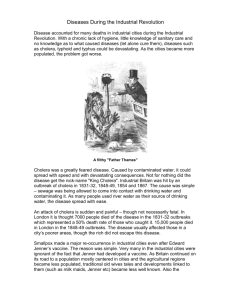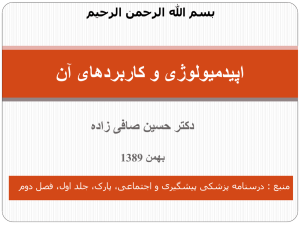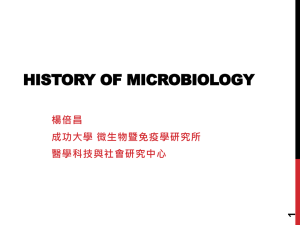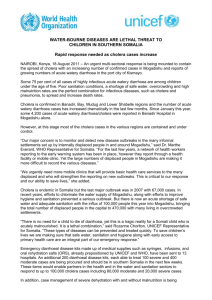Cholera prevention, notes for epidemic preparedness
advertisement
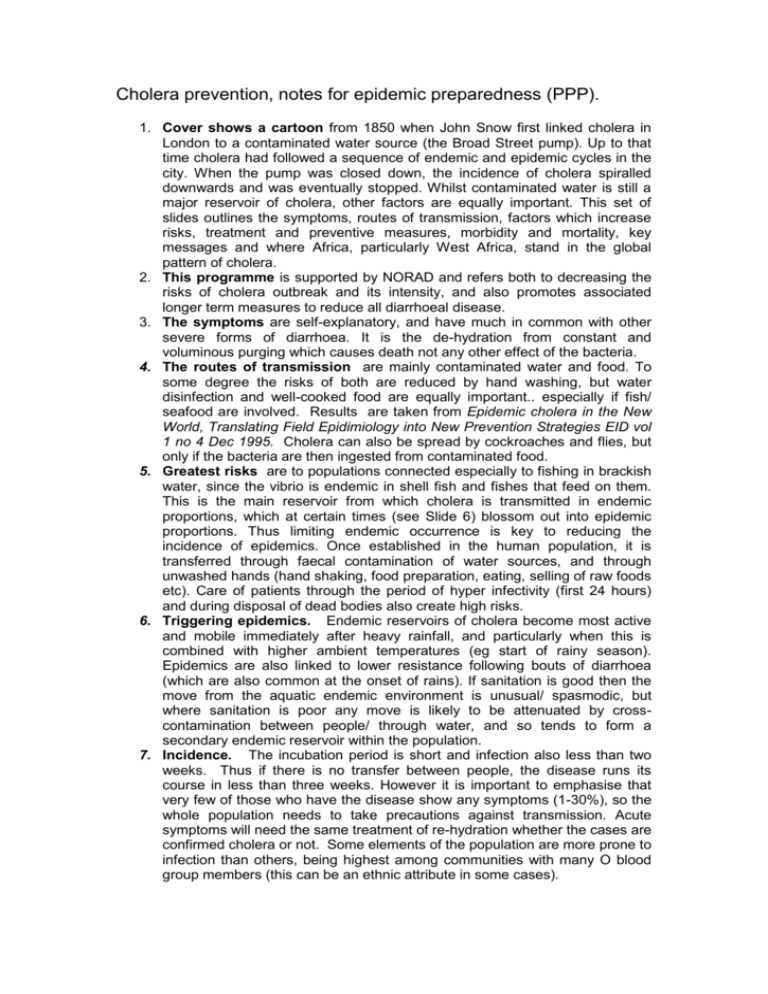
Cholera prevention, notes for epidemic preparedness (PPP). 1. Cover shows a cartoon from 1850 when John Snow first linked cholera in London to a contaminated water source (the Broad Street pump). Up to that time cholera had followed a sequence of endemic and epidemic cycles in the city. When the pump was closed down, the incidence of cholera spiralled downwards and was eventually stopped. Whilst contaminated water is still a major reservoir of cholera, other factors are equally important. This set of slides outlines the symptoms, routes of transmission, factors which increase risks, treatment and preventive measures, morbidity and mortality, key messages and where Africa, particularly West Africa, stand in the global pattern of cholera. 2. This programme is supported by NORAD and refers both to decreasing the risks of cholera outbreak and its intensity, and also promotes associated longer term measures to reduce all diarrhoeal disease. 3. The symptoms are self-explanatory, and have much in common with other severe forms of diarrhoea. It is the de-hydration from constant and voluminous purging which causes death not any other effect of the bacteria. 4. The routes of transmission are mainly contaminated water and food. To some degree the risks of both are reduced by hand washing, but water disinfection and well-cooked food are equally important.. especially if fish/ seafood are involved. Results are taken from Epidemic cholera in the New World, Translating Field Epidimiology into New Prevention Strategies EID vol 1 no 4 Dec 1995. Cholera can also be spread by cockroaches and flies, but only if the bacteria are then ingested from contaminated food. 5. Greatest risks are to populations connected especially to fishing in brackish water, since the vibrio is endemic in shell fish and fishes that feed on them. This is the main reservoir from which cholera is transmitted in endemic proportions, which at certain times (see Slide 6) blossom out into epidemic proportions. Thus limiting endemic occurrence is key to reducing the incidence of epidemics. Once established in the human population, it is transferred through faecal contamination of water sources, and through unwashed hands (hand shaking, food preparation, eating, selling of raw foods etc). Care of patients through the period of hyper infectivity (first 24 hours) and during disposal of dead bodies also create high risks. 6. Triggering epidemics. Endemic reservoirs of cholera become most active and mobile immediately after heavy rainfall, and particularly when this is combined with higher ambient temperatures (eg start of rainy season). Epidemics are also linked to lower resistance following bouts of diarrhoea (which are also common at the onset of rains). If sanitation is good then the move from the aquatic endemic environment is unusual/ spasmodic, but where sanitation is poor any move is likely to be attenuated by crosscontamination between people/ through water, and so tends to form a secondary endemic reservoir within the population. 7. Incidence. The incubation period is short and infection also less than two weeks. Thus if there is no transfer between people, the disease runs its course in less than three weeks. However it is important to emphasise that very few of those who have the disease show any symptoms (1-30%), so the whole population needs to take precautions against transmission. Acute symptoms will need the same treatment of re-hydration whether the cases are confirmed cholera or not. Some elements of the population are more prone to infection than others, being highest among communities with many O blood group members (this can be an ethnic attribute in some cases). 8. Treatment. Most deaths occur in the first 24 hours and almost all are as a result of de-hydration. If vomiting is not too great then re-hydration can be purely by ORT, using local ingredients, especially based on rice water rather than sugar solution, since the former is more effective in stopping purging. Extreme cases will need intravenous re-hydration, but in all cases it is recommended to give food as soon as possible once vomiting stops, to build up strength and stop diarrhoea.1 Anti-biotic is not usually necessary, but will shorten the time before full recovery. It should be noted that it is said that for re-hydration the most important thing is to get water into patients, the quality being almost immaterial since the bacterial load in any water is going to be only a fraction of that already in the patient and so unlikely to have any deleterious effect. 9. Prevention. The main prevention measures relate to blocking routes of transmission. However there are some which are not so easily identifiable from the routes and risks. These include aspects such as marinading seafood in citrus juice (eg. Latin American ceviche) and encouraging stomach acidity which kills the bacteria before ingestion. In general although vaccines have been developed for a long time, they have not proved very effective and are only recommended where populations are at greatest risk and least able to undertake other preventive measures (eg refugee camps). 10. Morbidity and mortality. Mortality rates are dropping for cholera as surveillance systems and treatment have improved. Almost 50% of cases used to die, but now most countries have brought this to less than 10% and some to less than 1%. Liberia is a case in point from which many could learn. 11. Beliefs and practices. Any hygiene promotion or other preventive measures will need to take notice of local beliefs and practices, some examples are listed, but each country or cultural group will have variations which will need to be taken into consideration. 12. Key messages. Starting re-hydration as soon as possible is really important, hence the countries with ORT corners appear to have lower mortality rates than others. Insufficient effort seems to be being made by most countries with endemic cholera to identify the reservoirs of bacteria from the cases which present in hospitals. Most efforts seem only to be made once incidence reaches epidemic proportions. We need to try and turn this around. 13. Africa’s global dominance. As a result Africa provides an increasing proportion of the total global cholera incidence, reaching 97% in 2003 from only 75% in 1998. There is therefore urgent need to improve the situation since the continent is almost becoming the global reservoir for cholera, and climate change is said to be increasing the risks. Within West Africa mortality rates are highest in CAR and Congo, and lowest in Liberia, although reporting systems may not be equally accurate everywhere. Of the focal countries a person is 20 times more likely to die from cholera once infected in Mali or Mauritania than in Liberia. These countries can perhaps think of adopting some of the treatment practices which have reduced mortality so significantly in other countries. On the other hand the proportion of the population showing cholera symptoms appears to be far higher in Guinea Bissau and Liberia than other countries, suggesting that these need to learn from the others on surveillance and preventive measures to reduce risks. Such aspects highlight the value of a regional perspective. 1 NB Where patients are treated centrally, the need for food but possible rules for isolation from family/ public may require some consideration since few hospitals provide food. UNICEF WCAR April 2006.




